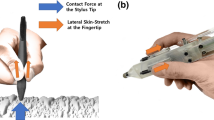Abstract
We have recently developed a compact, lightweight platform that can be worn on the finger of the user, so that haptic feedback can be generated directly on the fingertip pad rather than through a grasped instrument handle. A planar array of cylindrical coils and a 3D rigid-body motion tracker generate forces and torques on the magnet in the levitated platform worn by the user. This study compares perception of sinusoidal surface roughness across three different renderings: (1) with no torque feedback, (2) with torque feedback to follow the local surface slope, and (3) with torque feedback to prevent the fingertip from roll and pitch rotations. The results show that perceived roughness decreases with wavelength in all three conditions, but in addition, and independently, there are strong effects of torque feedback.
Access this chapter
Tax calculation will be finalised at checkout
Purchases are for personal use only
Similar content being viewed by others
References
Klatzky, R.L., Lederman, S.J., Hamilton, C., Ramsay, G.: Perceiving roughness via a rigid probe: effects of exploration speed. In: Proceedings of the ASME Dynamic Systems and Control Division, pp. 27–33 (1999)
Lawrence, M., Kitada, R., Klatzky, R.L., Lederman, S.J.: Haptic roughness perception of linear gratings via bare finger or rigid probe. Perception 36, 547–557 (2007)
Smith, A.M., Chapman, C.E., Deslandes, M., Langlais, J.S., Thibodeau, M.P.: Role of friction and tangential force variation in the subjective scaling of tactile roughness. Exp. Brain Res. 144, 211–223 (2002)
Blake, D.T., Hsiao, S.S., Johnson, K.O.: Neural coding mechanisms in tactile pattern recognition: the relative contributions of slowly and rapidly adapting mechanoreceptors to perceived roughness. J. Neurosci. 17, 7480–7489 (1997)
Massie, T.H., Salisbury, J.K.: The phantom haptic interface: a device for probing virtual objects. In: Proceedings of the ASME Winter Annual Meeting, Symposium on Haptic Interfaces for Virtual Environment and Teleoperator Systems, vol. 55, no. 1, pp. 295–300 (1994)
Klatzky, R.L., Lederman, S.J.: The perceived roughness of resistive virtual textures: I. Rendering by a force-feedback mouse. ACM Trans. Appl. Percept. 3(1), 1–14 (2006)
Kornbrot, D., Penn, P., Petrie, H., Furner, S., Hardwick, A.: Roughness perception in haptic virtual reality for sighted and blind people. Percept. Psychophys. 69(4), 502–512 (2007)
Unger, B., Hollis, R., Klatzky, R.L.: The geometric model for perceived roughness applies to virtual textures. In: Symposium on Haptic Interfaces for Virtual Environment and Teleoperator Systems, pp. 3–10 (2008)
Klatzky, R.L., Lederman, S.J.: Tactile roughness perception with a rigid link interposed between skin and surface. Percept. Psychophys. 61(4), 591–607 (1999)
Klatzky, R.L., Lederman, S.J., Hamilton, C., Grindley, M., Swendsen, R.H.: Feeling textures through a probe: effects of probe and surface geometry and exploratory factors. Percept. Psychophys. 65(4), 613–631 (2003)
Unger, B., Hollis, R., Klatzky, R.L.: Roughness perception in virtual textures. IEEE Trans. Haptics 4(2), 122–133 (2011)
Choi, S., Tan, H.Z.: A study on the sources of perceptual instability during haptic texture rendering. In: Proceedings of the IEEE International Conference on Robotics and Automation, pp. 1261–1268 (2002)
Wu, B., Klatzky, R.L., Hollis, R.: Force, torque, and stiffness: interactions in perceptual discrimination. IEEE Trans. Haptics 4(3), 221–228 (2011)
Berkelman, P.J., Hollis, R.: Lorentz magnetic levitation for haptic interaction: device design, performance, and integration with physical simulations. Int. J. Rob. Res. 19(7), 644–667 (2000)
Berkelman, P.J., Dzadovsky, M.: Magnetic levitation over large translation and rotation ranges in all directions. IEEE/ASME Trans. Mechatron. 18(1), 44–52 (2013)
Berkelman, P.J., Dzadovsky, M.: Single magnet levitation by repulsion using a planar coil array. In: 17th IEEE International Conference on Control Applications Part of 2008 IEEE Multi-conference on Systems and Control, pp. 108–113 (2008)
Brink, J.B., Petruska, A.J., Johnson, D.E., Abbott, J.J.: Factors affecting the design of untethered magnetic haptic interfaces. In: IEEE Haptics Symposium (HAPTICS), pp. 107–114 (2014)
Acknowledgment
This work was supported in part by National Science Foundation grants IIS-0846172 and CNS-0551515.
Author information
Authors and Affiliations
Corresponding author
Editor information
Editors and Affiliations
Rights and permissions
Copyright information
© 2014 Springer-Verlag Berlin Heidelberg
About this paper
Cite this paper
Aghajani Pedram, S., Klatzky, R., Isaac-Lowry, O., Berkelman, P. (2014). Virtual Roughness Perception Using Coil Array Magnetic Levitation Haptic Interface: Effects of Torque Feedback. In: Auvray, M., Duriez, C. (eds) Haptics: Neuroscience, Devices, Modeling, and Applications. EuroHaptics 2014. Lecture Notes in Computer Science(), vol 8618. Springer, Berlin, Heidelberg. https://doi.org/10.1007/978-3-662-44193-0_64
Download citation
DOI: https://doi.org/10.1007/978-3-662-44193-0_64
Published:
Publisher Name: Springer, Berlin, Heidelberg
Print ISBN: 978-3-662-44192-3
Online ISBN: 978-3-662-44193-0
eBook Packages: Computer ScienceComputer Science (R0)




